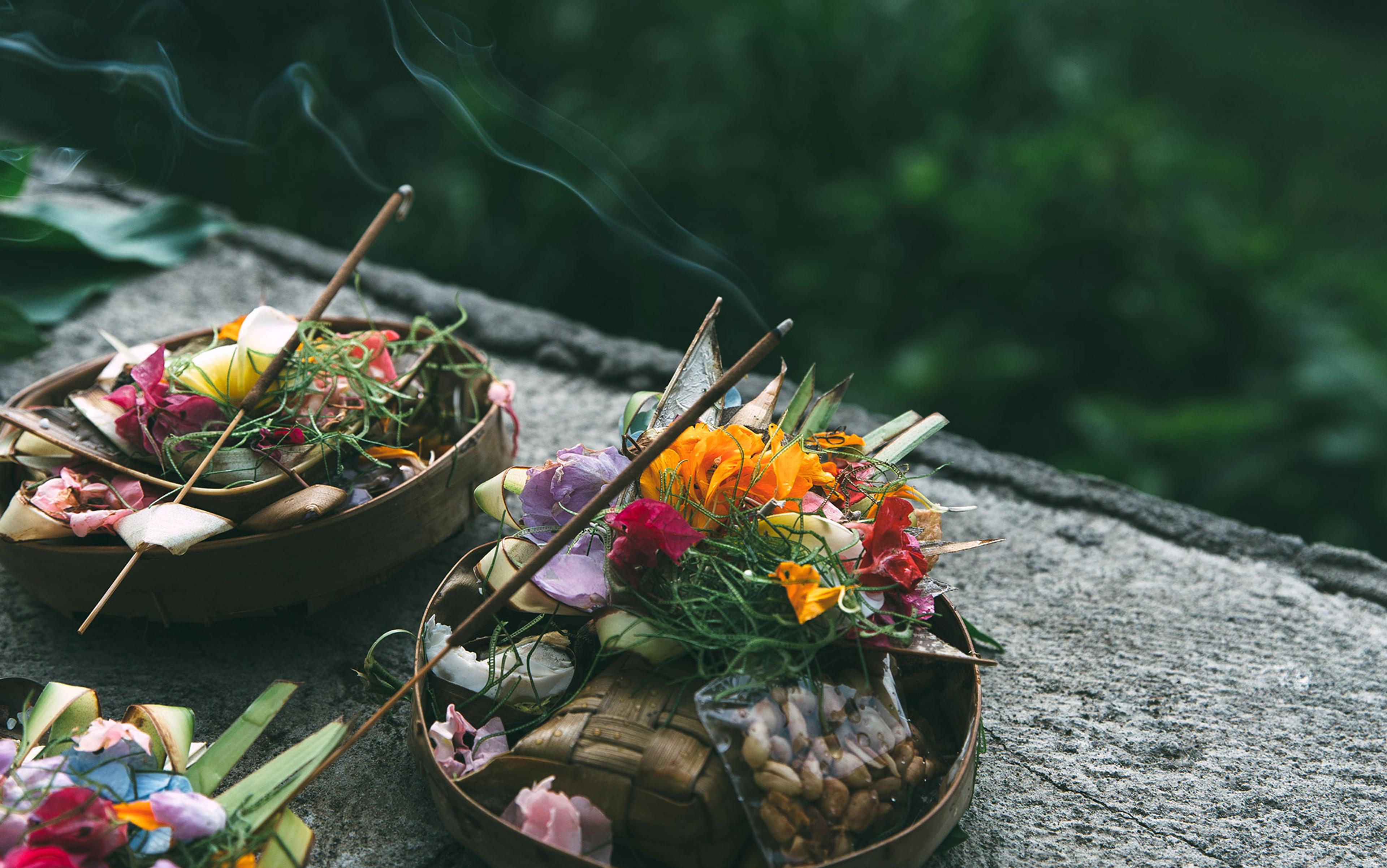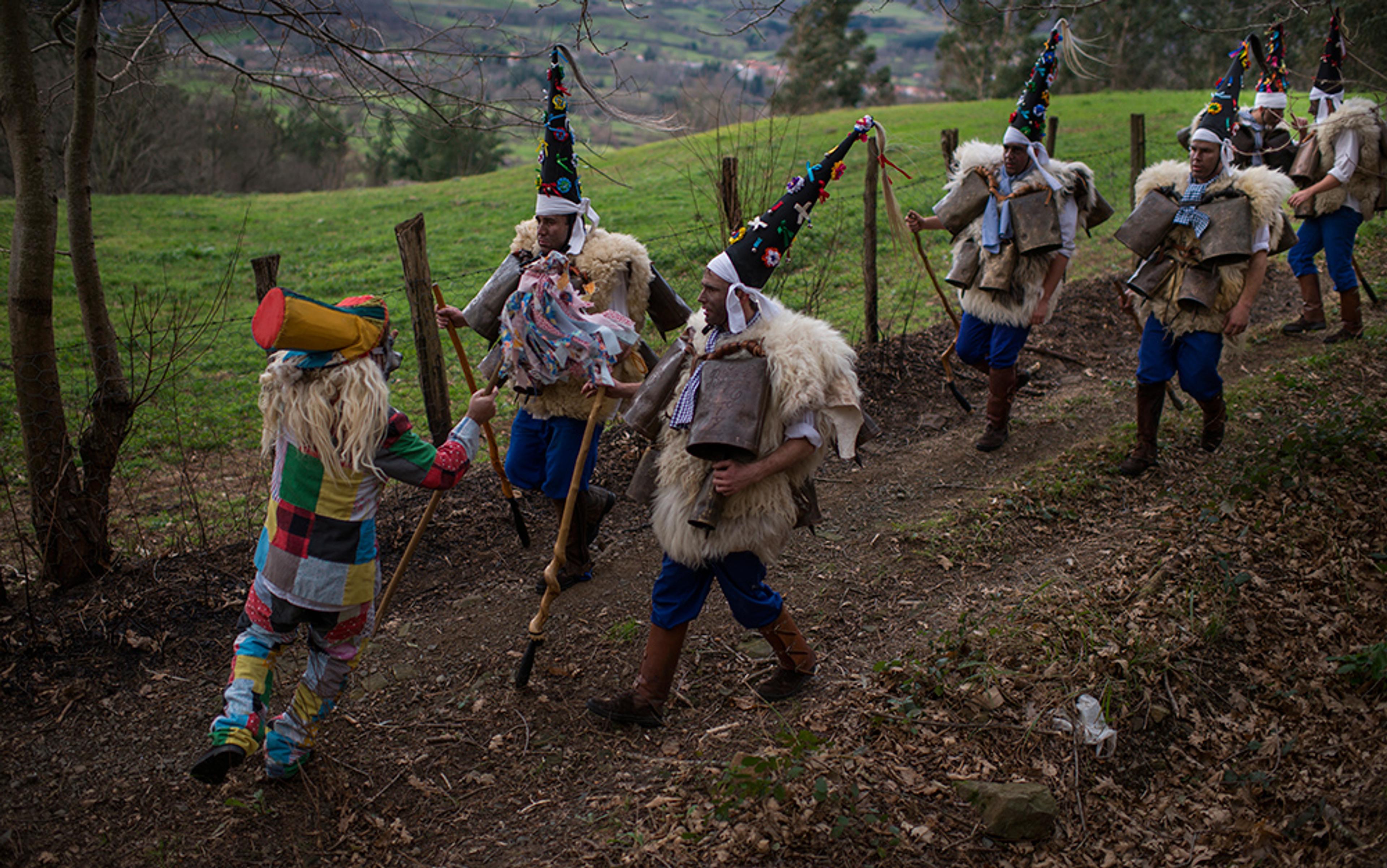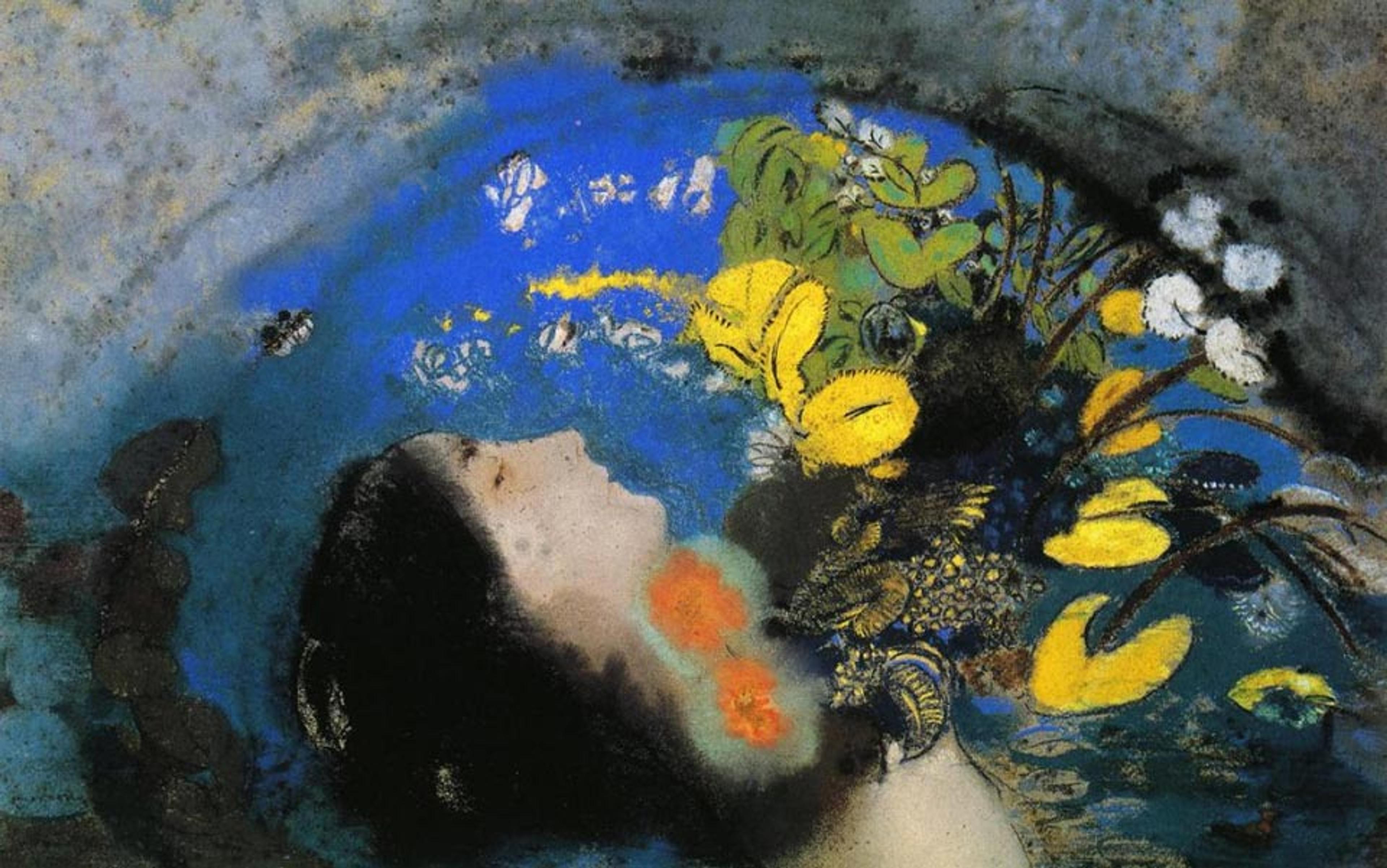Any tiddly doorway might have an offering; a one-pump petrol station, a shrine. At a waterfall, the spray is incense-scented, and a banyan tree is garlanded with flowers. The Balinese year is drunk with feast-days (more than 60 in a year), yet every morning women also make up to 50 small offerings. Each is made of a base of coconut palm containing petals, often of hibiscus, hydrangea and marigold, a few drops of water from a frangipani flower, and a whisper of a prayer. The offerings, called canang sari, can carry a little metonymic prayer too: a bus ticket to ask for safety on a journey, some small change representing the hope for a little more money, or a condom, suggesting, I was told: ‘More sex; less children.’ They are a kind of gossip to god, a hint let slip.
When visiting Bali last year to speak at the Ubud Writers and Readers Festival, I was wonderstruck by the ubiquity of ritual, so much so that on the pavements it is hard to avoid stepping on these beautiful little baskets of flowers in front of shops and restaurants. I was also moved by the way in which ritual vitalises the smallest of places. Any little nook can be sprung with a still-burning joss stick or a staircase lit with the bright beauty of marigolds: everywhere has a quality of having been acknowledged, so it is alive twice over, actually and then symbolically.
No culture and few individuals live without ritual. There are the inaugurations of presidents, student graduations, the rituals of temples, mosques and synagogues, Christmas lights or Easter’s ritual opening of the doorway of spring. While large, public rituals might be vulnerable to commercialisation, tedium or cynicism, they can also be freighted with significance, and shine with what Émile Durkheim in 1912 called the ‘collective effervescence’ of ritual, a shared grandeur beyond the individual.
For Indigenous Australians, ritual sings the natural world into continued life, in a diffuse and enspirited relationship between the Dreamtime ‘past’ and the present. The Dreamtime surrounds the present, having created the landscape and order of the world, giving meaning and profundity to life and reflecting cosmic order, while rituals of the ‘ordinary’ present, in turn, sustain the ‘extraordinary’ Dreamtime order. In Bali, the ferocious flamboyance of the traditional cremation of a king unbuckled a terrible divinity from the very clouds: arrows that turn into flowers, coffins shaped like lions, snakes of cloth, doves flying from the foreheads of women committing ritual suicide. In his book Negara (1980), the cultural anthropologist Clifford Geertz describes the lexicon of sensuous symbols in Balinese ritual, including carvings, flowers, dances, melodies, gestures, chants and masks, writing that the state rituals of classical Bali were ‘metaphysical theatre: theatre designed to express … the ultimate nature of reality and … by presenting it, to make it happen’.
Yet ritual is also alive in the slightest of phrases: a ‘thank you’ that enhances gratitude; a ghost of a god in ‘goodbye’ (god be with you); the grace spoken before eating. It is there in the little personal talismans touched a certain way for luck, because sometimes that one lucky strike of chance – before a journey, competition or meeting – is what ritual seeks to shelter, cradling the match to an Olympian flame. Given half a chance, habits seem to want to augment themselves into ritual: embellish a habit with attention, stylise it slightly, and it will elbow its way into the domain of rites, until even a cup of tea can be ceremonious.
Tiny, everyday rituals are a hand-crafted prayer to domestic order, beckoning the divine to step inside a moment. In Bali, the making of the canang sari offerings is done individually but its effect is a collective efflorescence. Canang means a basket of flowers, while sari means essence, and what is essential, I was told, is the right intent, a kind of purity, paying heed to the scripture of the Bhagavad Gita in which Krishna describes what god requires of an offering: ‘Whosoever offers to me with devotion a leaf, a flower, a fruit, or water, that offering of love, of the pure heart I accept.’ As in so many small rituals in so many cultures, an elemental grammar of nature is used: flowers suggest earth, candles suggest fire, then a little holy or purifying water, and the air is made visible by incense, with the ethereal element of prayer.
Do you pray? It is one of the most intimate questions. Do I? Yes, I pray – earthwise rather than to any off-ground god – and, though I cannot tell you the words I use, I will tell you their core is beauty. These prayers are the strongest elixir of my language. I put the essence of myself into them, but if anyone was looking, they would see no drama, no props, just breath and a certain abstraction from the mundane for a sweet minute. I pray in the mornings and my mind doesn’t feel right until I have done so. Mornings are more ritual-garlanded than other times of the day, readying oneself to steady the day. Rituals of exercise, yoga, meditation, journalling or dream diaries; rituals of washing and rituals of eating. (Breakfast is the most habit-bound of meals.) Creating internal order before the day unleashes its chaos, one attempts through ritual to decrease one’s own missteps, placating mischance.
In Bali, I spoke at length to one woman, Kadek, about her experience of making these offerings. She said that laying out the canang sari early set up her day. ‘If I don’t do canang sari,’ she told me, ‘I feel a bit lost and a bit dark. I feel that my step is not firm.’ They are cairns for the mind, walking its path through the day.
Yesterday’s wilted flowers, burnt-down joss sticks and miniature plates of rice are swept away, then the women dress in their temple-best, doing their hair and makeup with great care. When the incense is lit, a woman will take a frangipani flower, dip it in holy water, hold it between index and middle finger, sprinkle the shrine and then tuck the flower behind her ear. ‘That way,’ a woman in a guesthouse told me, ‘its scent goes through your words.’ I went with her as she put the canang sari around the family compound, the guestrooms and her corner shop, placing one on the shrine, another on the crisp shelf, and one between the beer and the biscuits, while a tinny radio advert was telling us to buy chocolate coffee, and a gecko zipped across the shrine. The shop, perhaps three metres square, was given six offerings.
The offerings are as unmonumental as the sparrow that feeds off them
The offerings themselves are the natural world writ little: constructed of a six-inch square of coconut palm, with a betel leaf placed at the base to honour the Balinese god Sang Hyang Widhi. The gods Brahma, Vishnu and Shiva are invoked in the various colours of the flowers, and also by the directions: Brahma, fire, is given red flowers in the south quarter; Vishnu, water, has blue flowers in the north quarter; Shiva, god of the five elements earth, water, air, fire and sky, has white flowers in the east, and orange or yellow flowers in the west quarter.
The canang saris last just one day, tracing the ephemeral as a breath clouds a mirror for a moment and is gone. The joss stick smoke in the breeze enacts the memory of a prayer whispered a minute before you came, while a wish tucked into a petal still swings in the air. In their slight grace – momentary, unsigned – they are the absolute opposite of the vast and vatic arrogance of an Ozymandias. The canang saris should include something edible for stray dogs and monkeys, sparrows, ants and butterflies, and one ex-street dog I met had survived solely thanks to the morsels scattered so widely on the pavements. At the edge of survival, the edge of the gutter and the edge of importance, the offerings are as unmonumental as the sparrow that feeds off them. Precisely because they are not precious, I prize them.
It is often the smallest of prayers that move me more than those intoned by priests or cathedralised in stone. When in 2013 I walked the Camino de Santiago across Spain, I came upon a ruined hermitage that was completely empty but full of prayers – hundreds of them – on scraps of paper, on the backs of biscuit wrappers, handwritten, fluttery, forlorn and imploring. In Aberdaron, at the end of the Llŷn Peninsula in Wales, in the church where R S Thomas used to be vicar, prayers are written on pebbles from the shore. The right pebble for a ritual prayer. The small prayers, sequestered in the secrecy of the heart, have an intensity that evaporates in larger ritual oration. As the Bible says: ‘Pray to your Father who is in secret. And your father who sees in secret will reward you in secret.’
Rituals are the doorways of the psyche, between the sacred and the profane, between purity and dirt, beauty and ugliness, and an opening out of the ordinary into the extraordinary. Canang saris are routinely placed at doorways, an unobtrusive hospitality to those who enter, blessing the spirit via the doorway of the senses. The front door is the most ritual-surrounded aspect of all domestic architecture – from horseshoes and Christmas wreaths to the Jewish mezuzah or the traditional strings of chillies and limes at Indian doorways. Even the aesthetics of doorway decoration work as unconscious ritual, whether it is a ‘Welcome’ mat, a pot of geraniums or a pair of lion gateposts. Doorway rituals separate the intimate from the public, the hearth from the street, the clean interior from the dirt of the street, but the doorway is also the place of arrivals and departures, beginnings and endings – a place of chance, good or bad. As with most rituals, the canang saris are offered at the doorway of the day: morning. The rituals expert Catherine Bell refers to ritual as a performance of conceptual orientations, and this is both psychologically and etymologically true, for sunrise – literally – orients the human spirit (‘orient’ etymologically refers to the rising of the Sun).
In a culture of ubiquitous ritual, rice – that most ubiquitous of food – is attended by rites in Bali, and every rice field has a sequestered place for rituals. Rice production demands exact irrigation, and the paddy fields are strictly regulated to distribute water fairly according to social justice and as needed by the plants. The water is metered by rite. ‘Ritual’ and ‘rite’ are from ritus in Latin, meaning the correct way of doing something, while the related Sanskrit term ṛta means regular order or, one could say, meter. Ah, lovely Rita, meter maid.
And here’s the thing. Rituals work – even for people who say they do not believe in them. Rituals alleviate grief, reduce anxiety and increase confidence. Rituals also aid self-control, as Scientific American reports, citing experiments that used ritual to regulate patterns of overeating. Psychology tells us that we infer self-image from our behaviour and, since ritual requires self-discipline, people performing ritual conscientiously come to see themselves as good at self-control, and hence become better at it. Unmetered behaviours can be metered by lovely ṛta.
In the dominant culture, ritual is often a stale, wilted word, as dusty and songless as Christmas decorations glimpsed in midsummer. Many people profess no clear religion and lack formal rites, and yet, even in ritual-poverty, a yearning persists to rekindle it from a stub of a candle, a petal and a word. There is a perceptible need for that numinous Other Place to which ritual gives passport – where no one is exiled and none a foreigner, and there is a defiant fecundity in contemporary ways of answering that need to give wishes wings.
Things at their dawnings and dyings seem to ask for ritual: births and deaths, a girl’s first period, a first kiss, a first solo journey. Both marriage and divorce ceremonies can be invented. In Ritual Theory, Ritual Practice (1992), Bell reports that therapists might use ritual with dysfunctional families, while rituals are composed for grief at the destruction of the Amazon. Meanwhile, at the Burning Man Festival in Nevada, invented ritual is the juice of the event, as each year a huge wooden temple is erected, and participants bring poems and prayers to the ritual culmination of burning, driven by a spirit that is democratic, convivial, radical and roaring.
In Bali, at the ‘Temple of the East’, where people greet the sunrise, a woman sprinkled me with holy water and then did her makeup: the Sun salutation of surya namaskar, then some mascara. But beauty rituals are not as skin-deep as they might appear. Animal behaviourists view grooming as the earliest of all human rituals, and suggest that much of human culture can be rooted in early animal ritualisation: courtship, mating, play, dance, art and education. There are ‘numinous themes’ in grooming rituals, according to human behavioural scientists, including the belief in a ‘before and after’ transformation; the healing qualities associated with grooming routines, the cleansing and purifying taking place in sequestered places of ‘contemplation and restoration’. Beauty ‘rituals’ can thus count as primal rituals, neither superficial, nor something to be despised, especially when people know no other rites. ‘The meaning of ritual is lofty indeed. He who tries to enter with the violent and arrogant ways of those who despise common customs and consider themselves to be above other men will meet his downfall there,’ said the Chinese philosopher Xunzi, in the 3rd century BCE.
You don’t have to believe in god to believe in the radiant divinity of flowers and their beneficent efficacy
The offerings are about making beauty, one Balinese woman emphasised to me. The poiesis or making of beauty, not the possessing of it, is the kind associated with art or poetry. Meanwhile, the effect of making beauty, a Balinese taxi driver told me, is that ‘your mind is surprised and happy. Beauty makes you feel pure, and purity is necessary for prayer.’ Intriguingly in the UK, some of the happiest of professions are the clergy, florists, beauticians and hairdressers, all doing work related to ritual activity, directly or indirectly.
In the canang saris, flowers are the symbol of beauty, and flowers attend rituals all over the world: flowers for birth and death, the doorways of life, flowers for social doorways, for guests and hosts, flowers to honour and to thank with the lightest touch – a petal-weight of unimpeachable beauty. You don’t have to believe in god to believe in the radiant divinity of flowers and their beneficent efficacy.
A study by the University of North Florida in 2018 found that being given flowers was a powerful way to lower stress levels, particularly for women, to the extent that the study’s author Erin Largo-Wight concluded that flowers represented a public-health solution to stress. Meanwhile, a study by the Mizuho Information and Research Institute conducted in the Tokyo metropolitan area exposed 31 male office workers to 30 unscented pink roses (Rosa, Dekora) arranged in a cylindrical glass vase for four minutes. The result? ‘Data from this study support the presence of physiological and psychological relaxing effects of being exposed to flowers on office workers.’ All the more poignant for the unflowery language in which the results are delivered.
People want to give and receive flowers, to paint them, photograph them, grow them and arrange them. Flowering plants are quite literally a source of life; according to the botanist Walter Judd at the University of Florida: ‘If it weren’t for flowering plants, we humans wouldn’t be here.’ They are necessary, but they also illustrate the margins of grace beyond necessity – a rhapsody of colour where life sings: such is the veridical beauty of flowers. In terms of evolutionary aesthetics, the beauty of flowers is primal – they have sung a soft serenade for 130 million years, and their beauty was there before we humans were there to see it. And perhaps after.
Lovely ṛta is never so needed as now. Through the unregulated, unjust and unmetered use of resources, we have collectively created a cosmic disorder, and arguably the loss of ritual thinking is part of the reason. Some scholars argue that the loss of effective rituals leads to destructive behaviours, while the anthropologist Roy Rappaport in the 1990s called for a collective responsibility to ecological order, vitalised by ritualisation.
To me, the most eloquent example of this is demonstrated by the Shinto priests at Lake Suwa in Japan who ritually recorded the lake’s freezing. As it froze, ridges of ice were formed and, when the world is viewed with twice-sight and nothing is only what it seems, the ice-ridges were seen as the footsteps of the gods. For 255 years, there were only three years when the lake did not freeze. Then between 2005 to 2014, there were five years when the lake didn’t freeze. Since 2013, it has frozen over just once, suggesting a terrifying planetary disorder. Confucius considered that ritual propriety guides humanity into authentic goodness (ren). ‘If for a single day one were able to return to the observance of ritual propriety, the whole empire would defer to ren.’
The sweet paradox of small daily rituals is that the ordinary is intensified into the sacred through the numinousness of the absolutely commonplace, an illustration of immanent divinity, demonstrating that all it takes to find cascades of enchantment is a tender attention in which the natural living world is blessed by the psyche, and the psyche by the natural world. Ritual sculpts, shapes and polishes the spirit in a fineness of mind, the hearth of the heart tended and made more tender by the delicate touch of something little more than a thank you. So the slightest of ritual magic, turning on a breath, might open doorways on to a future; and life might be protected by a petal and the holiness of prayers.






